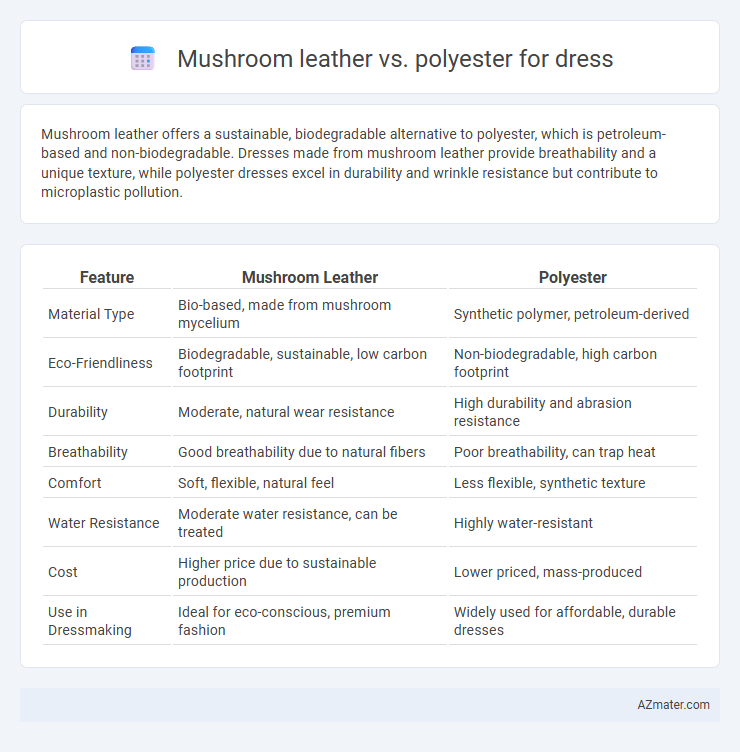Mushroom leather offers a sustainable, biodegradable alternative to polyester, which is petroleum-based and non-biodegradable. Dresses made from mushroom leather provide breathability and a unique texture, while polyester dresses excel in durability and wrinkle resistance but contribute to microplastic pollution.
Table of Comparison
| Feature | Mushroom Leather | Polyester |
|---|---|---|
| Material Type | Bio-based, made from mushroom mycelium | Synthetic polymer, petroleum-derived |
| Eco-Friendliness | Biodegradable, sustainable, low carbon footprint | Non-biodegradable, high carbon footprint |
| Durability | Moderate, natural wear resistance | High durability and abrasion resistance |
| Breathability | Good breathability due to natural fibers | Poor breathability, can trap heat |
| Comfort | Soft, flexible, natural feel | Less flexible, synthetic texture |
| Water Resistance | Moderate water resistance, can be treated | Highly water-resistant |
| Cost | Higher price due to sustainable production | Lower priced, mass-produced |
| Use in Dressmaking | Ideal for eco-conscious, premium fashion | Widely used for affordable, durable dresses |
Introduction to Mushroom Leather and Polyester
Mushroom leather, derived from sustainable mycelium, offers an eco-friendly alternative to traditional materials by mimicking the durability and texture of animal leather with less environmental impact. Polyester, a synthetic polymer made from petroleum-based products, is widely used in dressmaking for its affordability, durability, and wrinkle resistance but poses challenges related to non-biodegradability and microplastic pollution. Innovations in mushroom leather production emphasize biodegradability and lower carbon footprints, making it a promising material for sustainable fashion compared to the conventional polyester fabric.
Environmental Impact Comparison
Mushroom leather, derived from sustainable mycelium growth, offers a biodegradable alternative with significantly lower carbon emissions and water usage compared to conventional polyester, which is petroleum-based and contributes to microplastic pollution. Unlike polyester, mushroom leather production avoids toxic chemical treatments and reduces reliance on fossil fuels, enhancing its environmental profile. The biodegradability of mushroom leather allows it to decompose naturally, mitigating landfill waste problems inherent to non-biodegradable polyester fabrics.
Material Composition and Sourcing
Mushroom leather is crafted from mycelium, the root structure of fungi, offering a sustainable and biodegradable alternative to synthetic fabrics. Polyester, derived from petroleum-based polymers, relies on fossil fuels and involves energy-intensive manufacturing processes with higher carbon emissions. Sourcing mushroom leather involves eco-friendly agricultural methods that reduce environmental impact, whereas polyester production depends on non-renewable resources, contributing to pollution and microplastic waste.
Durability and Longevity
Mushroom leather offers superior durability compared to polyester, as it resists wear and tear while maintaining breathability and flexibility. Polyester, although durable and resistant to stretching and shrinking, tends to degrade faster with repeated washing and exposure to sunlight. Mushroom leather provides longer-lasting quality in dress materials, making it a sustainable and resilient alternative to synthetic polyester.
Comfort and Wearability
Mushroom leather offers superior breathability and flexibility compared to polyester, enhancing overall comfort in dresswear by reducing sweat accumulation and irritation. Its natural moisture-wicking properties help maintain skin dryness, making it ideal for prolonged wear. Polyester, while durable and wrinkle-resistant, lacks the same level of comfort due to limited breathability and potential for heat retention.
Aesthetic Qualities and Versatility
Mushroom leather offers a unique, natural texture with a matte finish that enhances the organic aesthetic of dresses, providing a modern yet earthy appeal. Polyester's smooth, consistent surface allows for a wide range of colors and patterns, making it highly versatile for various dress styles and designs. While mushroom leather exudes eco-friendly luxury and sophistication, polyester excels in durability and adaptability, catering to diverse fashion needs.
Care and Maintenance Requirements
Mushroom leather requires gentle cleaning with a damp cloth and mild soap to maintain its natural texture and prevent cracking, while avoiding exposure to excessive moisture and direct sunlight. Polyester fabric is highly durable and machine washable, allowing for easy stain removal and quick drying without the risk of damage from water. Both materials benefit from careful storage away from heat and prolonged friction to extend their lifespan in dress applications.
Cost and Market Availability
Mushroom leather, derived from mycelium, generally costs more due to its sustainable production process and limited manufacturing scale, contrasting with polyester's low cost and mass-market availability. Polyester remains widely accessible and affordable due to established synthetic fiber manufacturing and global distribution networks. The niche nature of mushroom leather restricts its presence to eco-conscious fashion brands, whereas polyester dominates dress materials in various market segments.
Future Trends in Sustainable Dress Fabrics
Mushroom leather offers a biodegradable and renewable alternative to polyester, which relies on petroleum-based materials and contributes to microplastic pollution. As sustainable dress fabrics gain momentum, innovators prioritize mushroom leather for its lower carbon footprint and natural compostability. Future trends highlight a shift towards biodegradable textiles like mushroom leather, reducing environmental impact while maintaining durability and aesthetic appeal in fashion.
Conclusion: Which is Better for Dresses?
Mushroom leather offers a sustainable, biodegradable alternative to traditional materials, with a soft texture and breathability ideal for eco-conscious dress designs. Polyester, known for its durability and affordability, provides easy care and vibrant color retention but contributes to microplastic pollution and relies on non-renewable resources. For dresses prioritizing environmental impact and comfort, mushroom leather is a superior choice, while polyester remains favored for budget-friendly, low-maintenance fashion.

Infographic: Mushroom leather vs Polyester for Dress
 azmater.com
azmater.com